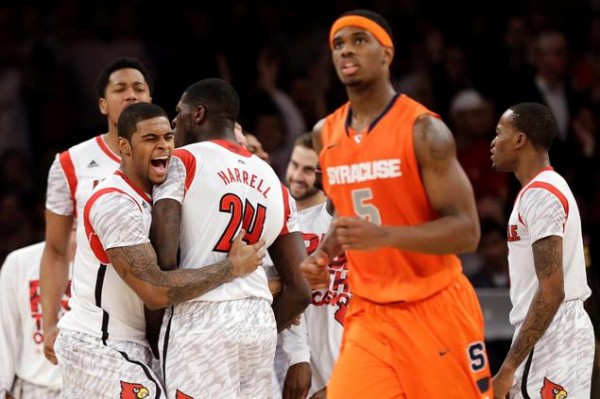Louisville Poised to Exploit a Manageable Field With Talent and Maturity
Posted by Will Tucker on March 20th, 2013With seven regular season games remaining on the schedule in mid-February, Rick Pitino called on his team to win them all. The Cardinals had just lost a demoralizing five-overtime road game to Notre Dame, capping a precipitous three-week fall that saw his team lose four of seven games and drop from #1 in the country all the way out of the top-10. While the Cardinals’ bout with the Irish was heralded by some as the game of the year for its suspense and intensity, Louisville fans shook their heads in resignation after their team choked away an eight-point lead in the final 45 seconds. The team hyped as the strongest national title contender in the Pitino era at Louisville couldn’t seem to generate enough offense outside of Russ Smith, couldn’t seem to generate the fast breaks it desperately needed, and couldn’t seem to close out games.

Chane Behanan was Montrezl Harrell’s biggest fan last Saturday, watching from the bench (AP Photo/Frank Franklin II)
So Pitino made an improbable request, and his team obliged. They built momentum by overwhelming St. John’s, Seton Hall, and DePaul; they subdued arch-rival Cincinnati and achieved redemption against Syracuse and Notre Dame. All the while, their glaring weaknesses slowly gave way to the singular strengths befitting a preseason consensus Final Four pick. The Cardinals’ backcourt, the sum of whose parts had yet to coalesce, came into form once Kevin Ware began playing extended stints at point guard, as he forced turnovers on defense and relieved Russ Smith of the fatigue of ball-handling duties while Peyton Siva was on the bench. Luke Hancock, the embattled James Madison transfer whose rusty early play drew groans even from press row in non-conference home games, quietly developed into a consistent 37% three-point marksman as his ailing shoulder strengthened. Gorgui Dieng fashioned himself into the Big East’s leading rebounder in conference play and proved he could still hit an elbow jumper despite the brace on his left wrist. All the while, the Cards forced opposing defenses to stretch ever further, opening driving opportunities for Siva after months of being thwarted by aggressive hedging and dense zones.
That offense, which raised doubts with its inability to generate points in the half-court, became the most prolific in the Big East as Ware’s mediation helped showcase strengths of Siva and Smith’s games that had been mutually exclusive. Against Syracuse in the Big East Tournament championship game, in the face of the perfect storm of disadvantageous circumstances –– a 16-point second-half deficit in a de facto road game to an athletic team that takes care of the ball –- the Cardinals proved they could still generate furious and sustained scoring with their defense. As Louisville launched an unrelenting 49-16 run over the last 16 minutes and scored four fewer points in the second half than the average Syracuse opponent scored in an entire game this season, it was hard not to look ahead to the Tournament.
Seeding, location, and draw notwithstanding, this is, elementally, Louisville’s most promising shot at an NCAA Championship in the Pitino era. On paper, the field contains no insurmountable roadblocks; no dead ends in the bracket at which point reasonable fans might shrug and say “we’ll give it our best shot.” There is no 2007 Florida, 2009 North Carolina or 2012 Kentucky waiting in the wings to thwart a six-game run. Barring a major setback, Louisville is likely to be favored against every potential opponent in its path, with the possible exception of a title bout with Tom Crean’s Hoosiers, whom Las Vegas sports books have assigned the second-best odds to win the Tournament. And the Kentucky Wildcats, that other imposing figure in the triumvirate of preseason favorites and author of the Cardinals’ demise in 2012, lost their NIT debut in front of 3,400 people in Pittsburgh last night.
In other words, circumstances have aligned for the program’s first National Championship in almost three decades, and this season’s Cardinals seem to possess the right constitution to exploit those circumstances. The last Louisville team to earn an overall #1 seed –– that 2009 edition that fielded two lottery picks, two former five-star centers and a bevy of upperclassmen –– ultimately succumbed to frustration as egos and entitlement curdled to the surface in the Elite Eight. Last year’s Final Four team subsisted on defense and enthusiasm, but couldn’t overcome an anemic offense. This season’s roster seems to balance a Final Four-caliber talent quotient with unwavering mutual affection and emotional maturity. The latter is evident in glimpses of Chane Behanan cheering ecstatically from the bench as his freshman substitute takes over the Big East title game; when Dieng declares he plays basketball “to have fun with people,” and wants to play in the NBA “to change people’s lives” back home in Senegal; or when Siva and Smith embrace Toy Story and Christmas elf motifs posed by fans to characterize their relationship.
Pitino’s appeal to win out in the regular season resonated with his team, and after the Cardinals beat Notre Dame on senior day to clinch their seventh straight, Behanan reiterated the sentiment with a simple message on the locker room dry erase board: “nine games.” A week later, six wins separate Behanan’s team from an NCAA Championship. Certainly, history is full of favorites who were outmaneuvered on any given night –– it’s that sense of chaos and immediacy in a single-elimination format that make the NCAA Tournament so appealing. But the Cardinals appear as battle-tested as anyone, and it’s hard at the moment to identify a team more likely to weather the chaos and emerge unscathed on April 8.












































[…] post appeared on Rush The Court’s Big East microsite on Wednesday, and it’s still relevant after the Cardinals dismantled North Carolina A&T […]